Please use the following link to download the April 12, 2025 issue of the syəcəb
Category: Tulalip News
Celebrate Autism Acceptance Month with bubbles!
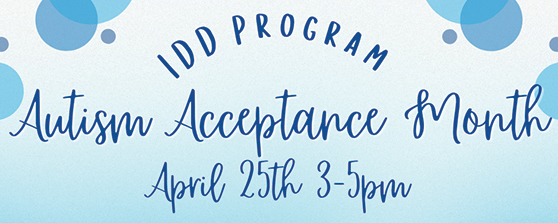
By Kalvin Valdillez, Tulalip News
A certain cartoon sponge once famously said, “We’re not just blowing bubbles, we’re making bubble art!” He quickly backed up this statement by using his special technique to conjure a butterfly from his bubble wand, while also unintentionally annoying his underwater neighbor.
As hilarity ensued in the bubble-centered Spongebob Squarepants episode, Spongebob’s unwavering fondness for sudsy orbs shined a bit of light on the important role bubbles play in brain development and cognitive function. Examples of this include patience, perception, creativity, sensory integration, visual tracking, hand-eye coordination, cause and effect, social interaction/skills, and even motor skills.
Now, though bubbles are beloved by people of all ages, children who are diagnosed with an Autism Spectrum Disorder (ASD) take a particular shine to bubble play. This is most likely because it helps fulfill so many of their sensory needs by offering an engaging and calming experience.
A few years back, in April 2012, a nonprofit called Faces 4 Autism embarked on an initiative to set a Guinness World Record for the most people blowing bubbles at the same time and invited schools and families across the nation to participate. After achieving this amazing feat, bubble play became a staple at Autism Awareness/Acceptance Month events throughout the country. And this year, the Tulalip Family Haven’s IDD program is hosting a bubble-themed gathering on April 25, to celebrate Autism Acceptance Month on the rez. Or as Spongebob would say, they are gearing up to ‘bring it around town’.
Autism is a common, yet very complex, intellectual developmental disability that has significantly been on the rise over the past few decades. According to the Centers for Disease Control and Prevention (CDC), one in thirty-six children in the United States are diagnosed with an autism spectrum disorder. That study also shows that Native children are affected at a similar rate as other races and ethnicities, but that does come with a caveat.
Because of a lack of resources on reservations and access to mental health care, many Indigenous kids are diagnosed later on in life, during their pre-teen years. In comparison, non-Native children living with ASD are typically diagnosed by the age of three. Early indicators include language delay, repetitive behavior, obsessive interests, as well as social and communication challenges. The CDC states that children living with ASD have different ways of learning, moving, paying attention, and interacting with the world around them.
Furthermore, research conducted by the American Academy of Pediatrics showed that Native youth are 13% less likely to be identified with autism in early childhood, while non-Native kids are 1.5 times as likely to receive an ASD diagnosis at a young age. And those low statistics and the lack of available knowledge surrounding IDD tends to lead to negative misconceptions, denial, and a feeling of despair once an Indigenous child is diagnosed with any form of IDD.
With the prevalence of ASD on the rise, many communities are slowly transitioning from participating in Autism Awareness Month to celebrating Autism Acceptance Month, including Tulalip.

Said Alayna Helland, IDD Case Manager at Tulalip Family Haven, “Awareness is important, but acceptance is also vital. To show acceptance of individuals with autism, it’s important to focus on everything they can do instead of focusing on what they can’t do. People with autism are often gifted with unique abilities like exceptional memory, heightened attention to detail, strong visual-spatial skills, and unique perspectives on problem solving.”
In preparation for Autism Acceptance Month, Alayna reached out to Tribal member and a parent of a child with ASD, Cara Mccoy. Cara spoke on the difficulties Tribal families face with the lack of inclusion when it comes to attending community gatherings. Cara shared, “We rarely go to the events because there are a lot of people and it’s loud. To do more things in the community, offer sensory-friendly events. Have a sensory room at the more significant events.”
The IDD Support for Families program was developed in 2023 to help Tulalip community members with an ASD or IDD diagnosis by bridging the gap between the reservation and the available resources.
The program is referral-based and takes both outside referrals, from other tribal programs and/or the Marysville School District, as well as self-referrals where a family can request services by either in-person appointments or by completing an online application on Family Haven’s Tribal department webpage. They offer their services to Tulalip tribal members as well as to other Natives who live in Snohomish County. IDD services include monthly play groups, weekly support groups, community outreach, connecting families with resources, and assistance with any applications in regard to their child’s needs such as medical, disability, and caregiving.
When asked about the importance of celebrating Autism Acceptance Month, Alayna stated, “It is important to celebrate because Studies have shown that children in Native American communities are less likely to have access to a specialist to receive a diagnosis and are less likely to have an early intervention. Early intervention is crucial for children with autism because it maximizes their potential for positive outcomes by addressing developmental challenges early, improving essential skills like communication and social interaction, and enhancing independence and overall quality of life.
“The IDD program assists in connecting families with providers that can diagnose Autism and ADHD, and it’s important that our community knows this resource exists so early intervention is possible. The IDD program holds events throughout the year that are accommodating to our community members with Autism. On April 25, we are celebrating Autism Acceptance Month at the Mission Highlands building. We will have sensory activities for the children, early dinner, and information and resources for anyone interested in the program.”
The Autism Acceptance Month bubble blast bash will take place from 3:00 p.m. – 5:00 p.m. at the Mission Highlands park on the last Friday of April. For more details about the IDD program or the upcoming gathering, please contact (360) 716-4935.
Welcoming Home our Vietnam Vets
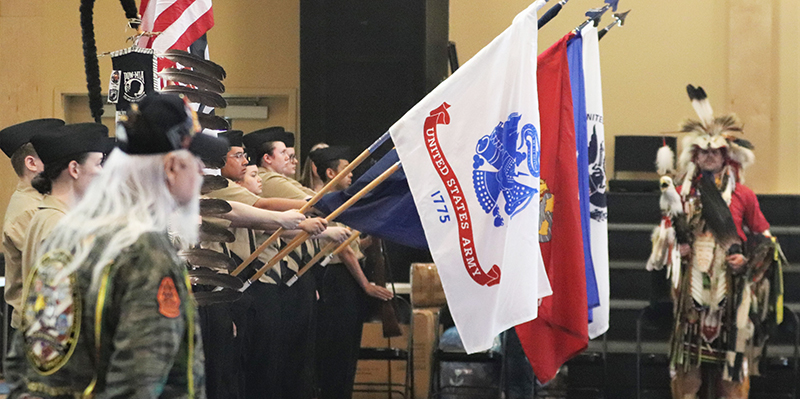
By Micheal Rios, Tulalip News
A truly heartfelt and emotional event took place recently that brought together veterans, families, and community members from all walks of life. The event, named “Welcome Home Vietnam Veterans,” was organized by respected Tulalip elder and Vietnam veteran, Andy James.
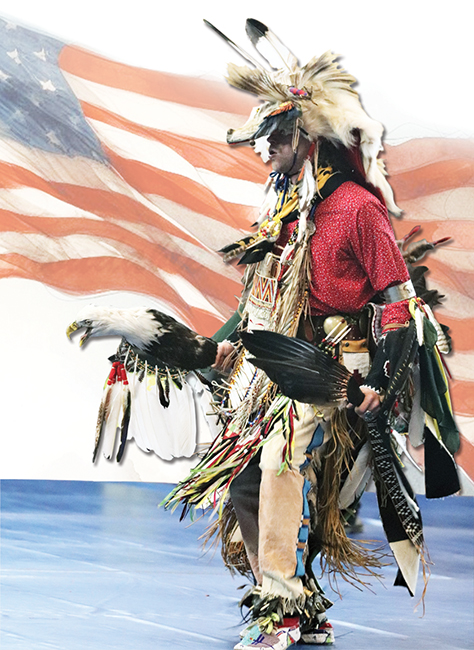
Andy, now 69, served in the U.S. Marine Corps from 1975 to 1977 where he earned the rank of Private First Class. After returning home nearly five decades ago, he, like many others who served their country during the tumultuous Vietnam War, was not met with gratitude. Instead, they returned home to resounding hostility or even worse, spirit piercing silence.
For the past 12 years, he’s made it his mission to ensure that the sacrifices of Vietnam veterans are acknowledged, honored, and remembered. Since 2013, Andy has organized a veteran-led gathering at Tulalip to bring the Native community together with compassionate individuals and local organizations who wish to give those past warriors the welcome home they were previously denied.
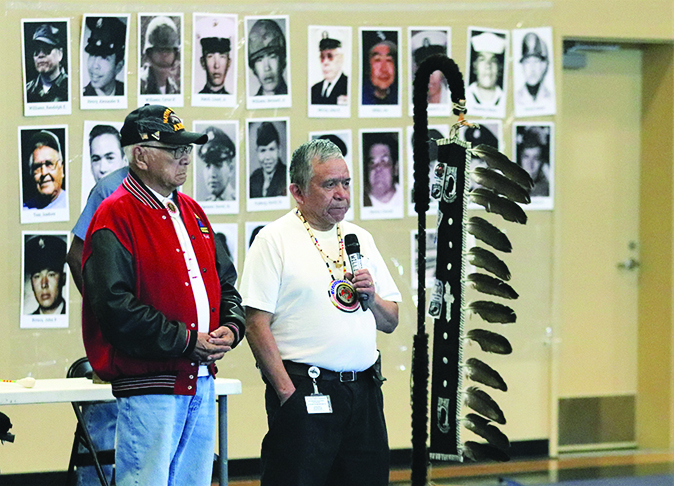
“That first gathering in 2013 was achieved by word of mouth alone. I roamed around Snohomish, Skagit and Whatcom Counties letting people know what my intentions were,” Andy explained during the 2025 event, held at the Tulalip Youth Center. “That first year 40 veterans showed up. They were impressed, the non-Indians in particular, and shared with me they wished they had something similar in their respective communities. Most don’t get to experience the love our Indian people extend to our veterans and elders.”
The morning-long gathering blended traditional Native ceremonies with modern tributes. It opened with a smudging ritual and drum circle, followed by a 13-student color guard from Marysville School District, which included an honorary bugle player.
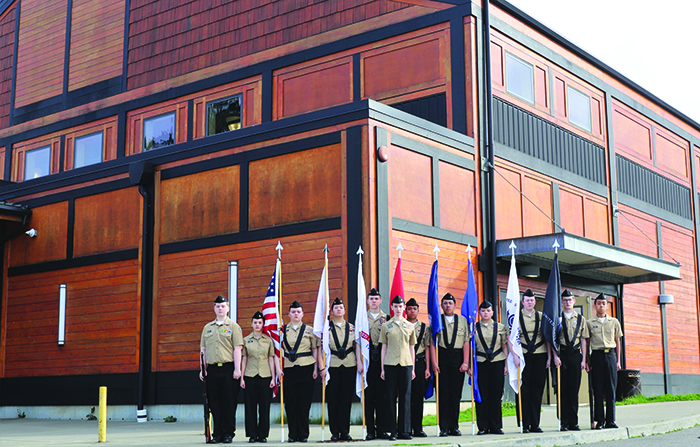
Chief Kathleen Wilde, naval science instructor for Marysville School District, led the color guard. “When we were invited to participate, the kids were very excited and considered it a great honor,” she shared. “It’s so important for veterans of every branch and community to be able to teach the students what it meant to serve and what it still means to serve our country. These lessons that only veterans can teach and share are invaluable. I’m humbled to be here and just so grateful that the students were included. This is something they’ll never forget.”
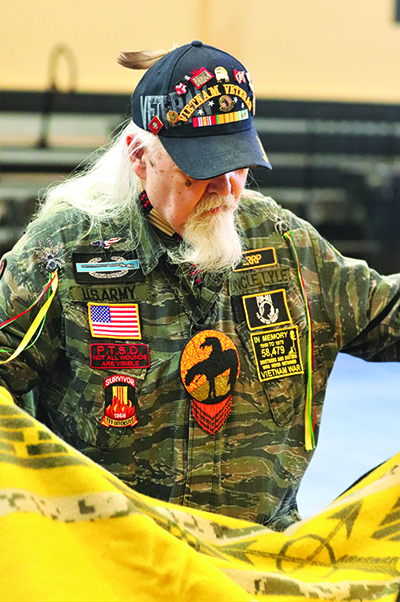
The Welcome Home Vietnam Veterans events included tear-evoking testimonials from vets willing to share their experiences of war and their return, as well as intertribal dances, flute music, songs from two drum circles, and a communal meal. A true sight to behold was a solo powwow dancer fortified by a wolf headdress and full-bodied eagle staff. He summoned the warrior spirit within that shared space and managed to radiate healing medicine for all who needed it.
Andy emphasized that one of his goals was to use the event to share Native traditions with the wider community. “We’ve always had ceremonies for returning warriors,” he said. “This is our way of showing gratitude and helping the spirit return home. I want all people, all veterans, Indian and non-Indian, to experience the power of our culture.”
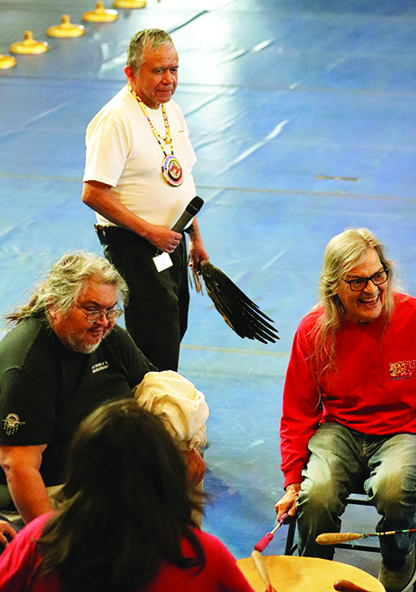
According to the U.S. Department of Veterans Affairs, Native Americans serve in the Armed Forces at five times the national average, having the highest per-capita involvement of any other ethnic group. Yet, those stories are often left out of the broader narrative. Events like Welcome Home Vietnam Veterans aim to change that by platforming the voice and experiences of Native vets.
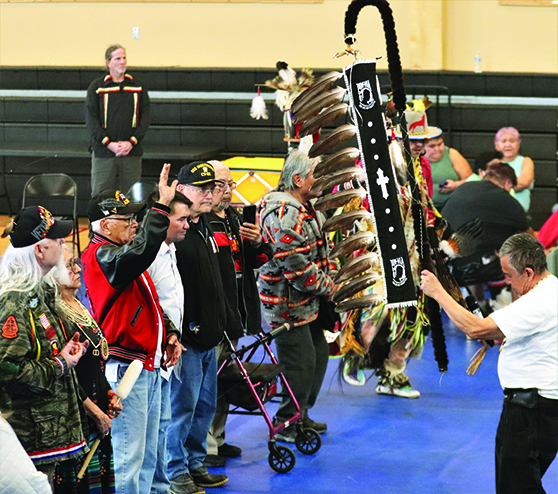
One of Tulalip’s oldest living tribal members, 94-year-old Hank Williams Sr., attended the event and praised Andy’s continued efforts. “This is powerful. Shows one person can bring us together,” the proud U.S. Army veteran (1952-1954 Korean War) said before taking to center floor during a ceremonial salute to vets.
Protecting children and empowering families
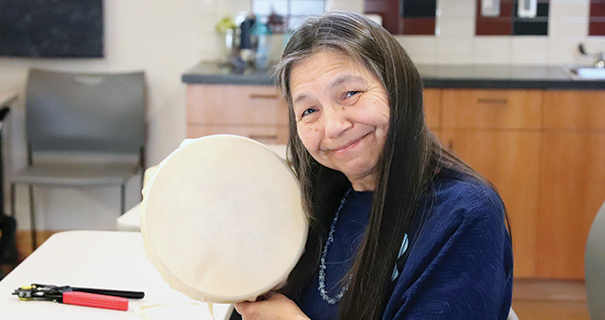
By Wade Sheldon, Tulalip News
Each year, hundreds of thousands of children in the United States experience the trauma of abuse and neglect. According to the National Children’s Alliance, one in four girls and one in 13 boys will experience child sexual abuse. This devastating reality underscores the importance of community action and support. In 2022 alone, 558,899 children were identified as victims of abuse and neglect, and by 2024, Child Advocacy Centers across the nation had served over 372,000 children facing allegations of abuse.
In recognition of National Child Abuse Prevention Month, Tulalip’s Children’s Advocacy Center held a community awareness event at the Hibulb Cultural Center on Thursday, April 3. This gathering brought together representatives from various tribal departments to showcase a plethora of resources aimed at supporting children facing abuse and adversity. The event underscored the critical importance of vigilance and compassion within our community, encouraging attendees to become more aware and active in protecting our youth.
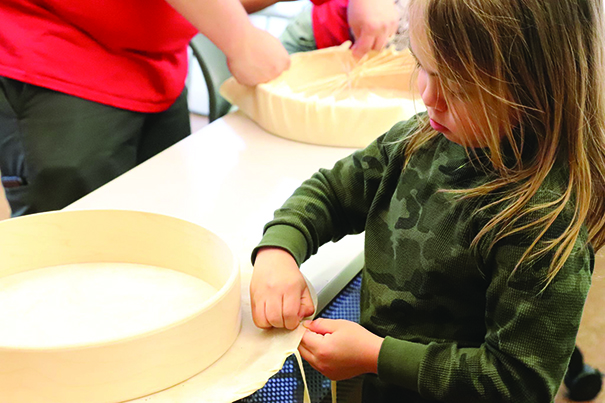
Coinciding with Hibulb’s free admission day, which takes place on the first Thursday of every month, the event featured engaging activities such as a drum-making class and a beaded bracelet workshop. Attendees also had the opportunity to visit booths from Family Services, beda?chelh, Tulalip Bay Fire Department, Tulalip Office of Civil Legal Aid, and Child, Youth, and Family Mental Wellness, which provided valuable information and resources to enhance community support for children in need.
Sue-Mei Slogar, Social Worker for beda?chelh said, “Essentially, CPS can be scary, and people don’t really understand our role and think we are just coming in and taking kids away. A lot of what we do is provide resources for families that need help getting connected to resources in the community and giving them resources we have at our end. We aim to keep kids and their guardians together and strengthen their relationship. And to stop child abuse and child neglect. Also, to help parents be there for their kids.”
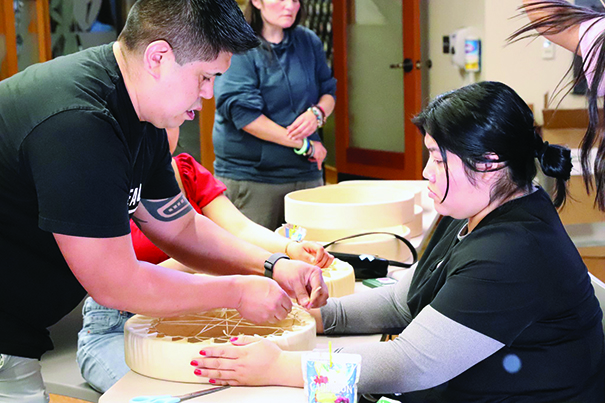
Explaining her perspective on the importance of these events, Slogar emphasized that many individuals in need of assistance often feel lost regarding where to seek help. She stated, “A lot of time when people need help, they don’t know where to go and turn to.” Slogar believes that making the community aware of the services available enables those in need to reach out before a crisis occurs. She added that it is essential for the community to understand that support is accessible, saying, “I think that’s helpful for the community to know our presence and build those relationships before something negative happens.” This proactive approach fosters strong connections and ensures a supportive environment instead of waiting until problems escalate.
The Child, Youth, and Family Mental Wellness booth offered resources on grief, stress relief, and self-care tips. They provided fun gifts for children, such as beach balls, to help them practice healthy breathing techniques. Clinical Supervisor Sarah Wright explained, “We are here to bring some awareness to mental health and creative ways to calm ourselves and bring our stress down.”
The Tulalip community’s dedication to preventing child abuse and supporting families was reflected in the heartfelt collaboration and meaningful activities at the awareness event. As these efforts continue, it is vital to remember that help is always within reach. Whether you are a child, parent, or community member seeking guidance, remember that you are not alone. For support and resources or to learn more, contact the Tulalip Children’s Advocacy Center at (360) 716-5437 or email childadvocates@tulaliptribes-nsn.gov
April 5, 2025 syəcəb
Please use the following link to download the April 5, 2025 issue of the syəcəb
Federal judges view Tulalip as restorative justice leaders
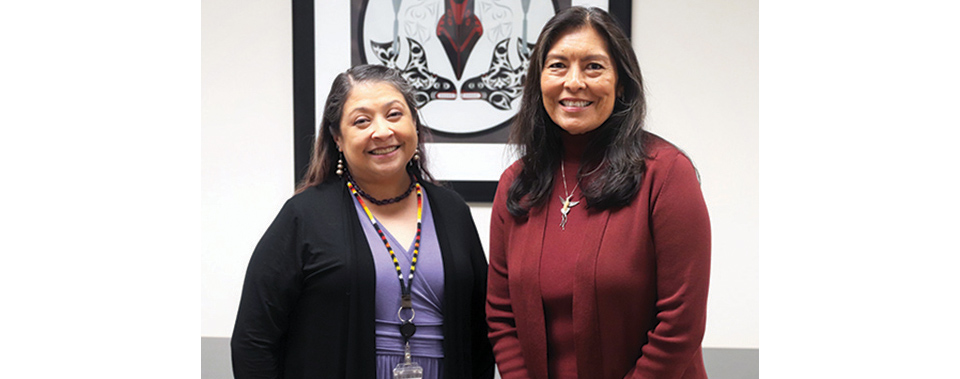
By Micheal Rios, Tulalip News
In a historic visit, federal judges from the Ninth Circuit Court of Appeals Committee on Tribal and Native Relations recently visited Tulalip Tribal Court. The purpose of their visit was to inquire about and observe firsthand how holistic justice is practiced within a tribal legal system. This rare and significant event highlighted the growing recognition of tribal justice systems and their potential impact on broader judicial practices.
“The Ninth Circuit has by far the largest populations of Indigenous peoples and Indian nations as compared to other circuits in the nation,” said Judge Diane Humetewa, Chair of the Tribal and Native Relations Committee. Judge Humetewa (Hopi) made history in 2014 when she became the first Native American woman to ever serve as a federal judge. “Eighty percent of Indian Nations’ tribal population is within the 15 districts of the Ninth Circuit. As one of the objectives in the Committee’s charter states, we seek to better understand the common concerns related to judicial functions and open communication.”
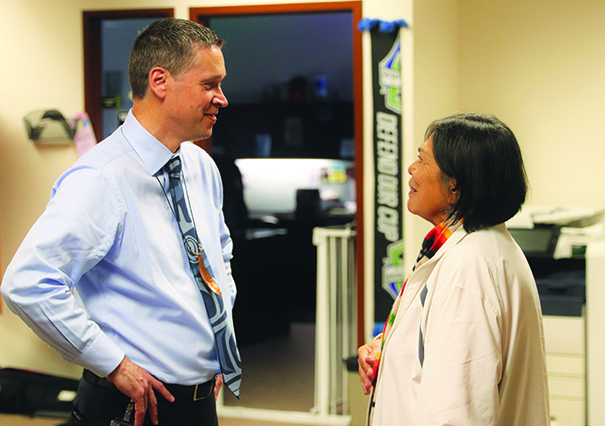
The well-respected judicial visitors were welcomed by Chairwoman Teri Gobin, special projects manager Patti Gobin, Tribal Court executive director Tate London, and Tulalip’s current presiding judges, the honorable Meredith Drent, Christine Frausto, Peter Boome, Mark Pouley and Thomas Miller..
Spanning the morning of March 28, the visit took place at Tulalip Tribal Court, a courthouse within the jurisdiction of the Tribe’s 22,000-acre reservation that is governed by its own laws and justice system. The Ninth Circuit Court of Appeals plays a crucial role in legal matters affecting tribal communities. By engaging directly with Indigenous legal practitioners, the Ninth Circuit judges sought to better understand the nuances of tribal justice systems and how they differ from the conventional colonial model.
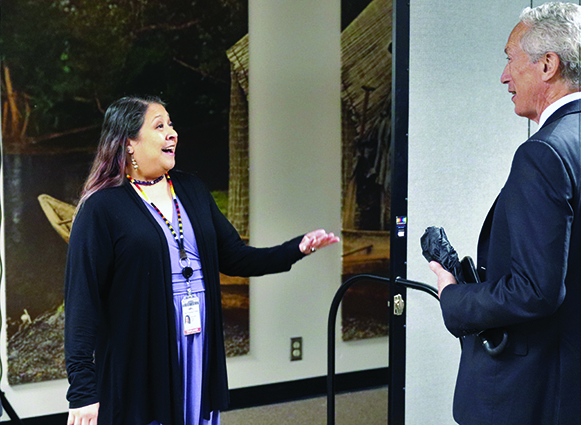
Unlike the traditional U.S. court system, which often prioritizes punishment and incarceration, many tribal courts emphasize restorative justice – an approach that seeks to heal relationships, rehabilitate offenders, and restore balance within the community. The visiting judges learned of Tulalip Court’s procedures that incorporate mediation, community involvement, and cultural traditions, such as talking circles and elder guidance.
“Restorative justice is about addressing harm, not just punishing crime,” explained Chief Judge Meredith Drent of the tribal court. “Tulalip Court’s services to the community include Healing to Wellness, Mental Wellness, and Family Wellness Court, Tulalip Office of Civil Legal Aid (TOCLA), Probation, and Tribal Court Elders Panel. These services are dependent upon judges, case managers, and service providers who are well-versed in cultural sensitivity and are driven to collaborate and partner with other necessary programs in order to heal the individual and mitigate future harm.”
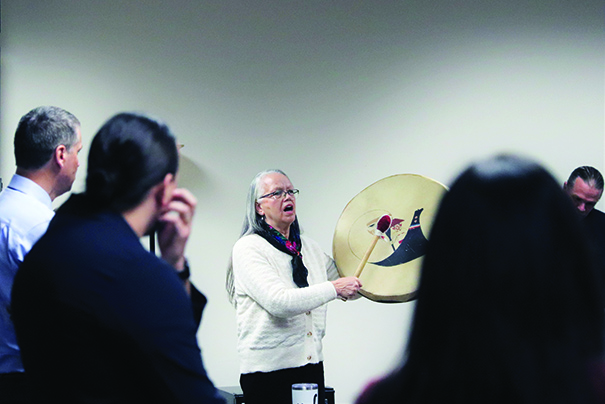
For the Ninth Circuit committee members, the experience provided valuable insight into a justice system that is both effective and culturally grounded. In many Tulalip Court cases, holistic practices have led to lower recidivism rates and stronger community ties, outcomes that have drawn increasing interest from legal scholars and policymakers.
With increasing discussions on criminal justice reform, restorative justice models, such as those seen in tribal courts, are attracting national attention. Some advocates argue that restorative justice principles could be integrated into the U.S. legal system to address issues like mass incarceration, youth rehabilitation, and community healing.
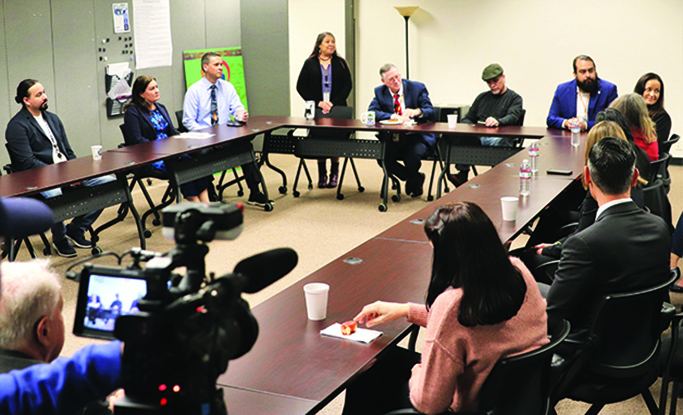
As the Ninth Circuit’s visit concluded, both tribal and federal judges expressed optimism about future collaboration and dialogue. “We’re hopeful for the opportunity to develop a collaboration with the Federal District Court for Western Washington,” said Tulalip Chief Judge Drent. “A collaboration where we can share resources and knowledge, but also develop methods so that when people interact with the federal system, they have ways to come home and put their best foot forward if there is an opportunity to do so.”
The honorable Judge Humetawa added, “Meeting with the Tulalip Chief Judge, Tribal Judges and court staff provided a rare opportunity for federal judges in the Western District Court of Washington and members of the Ninth Circuits Committee on Tribal and Native Relations. Identifying areas of mutual concern in adjudicating cases that arise from tribal communities, such as Tulalip, can only happen when we meet in this way.”
Athletes honored after historical winter sports campaign
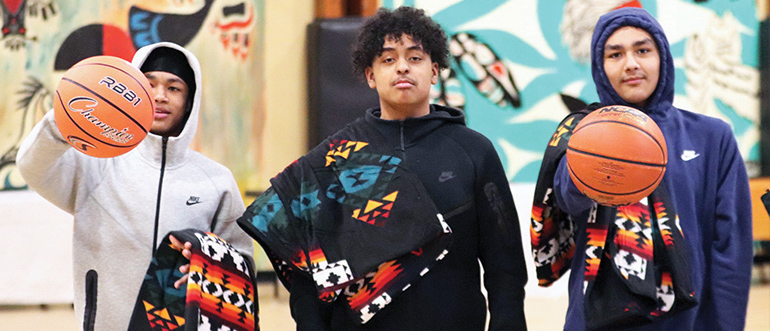
By Micheal Rios, Tulalip News
This past winter sports season, spanning from December to March, dozens of Tulalip youth showcased their athletic prowess on the highest stages of amateur competition. Marysville Pilchuck wrestling and Tulalip Heritage basketball both garnered state-wide recognition enroute to making school history, while other Tulalip high schoolers and middle schoolers showed out in their respective sports and postseason tournaments.
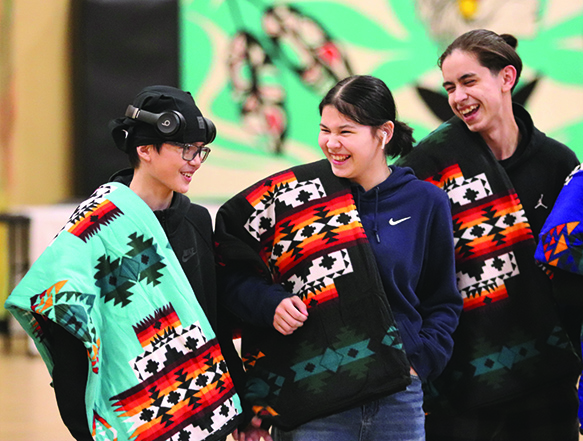
To honor all those athletes who contributed to making the winter campaign unforgettable, the Youth Enrichment division hosted a stirring event at the Youth Center on March 28.
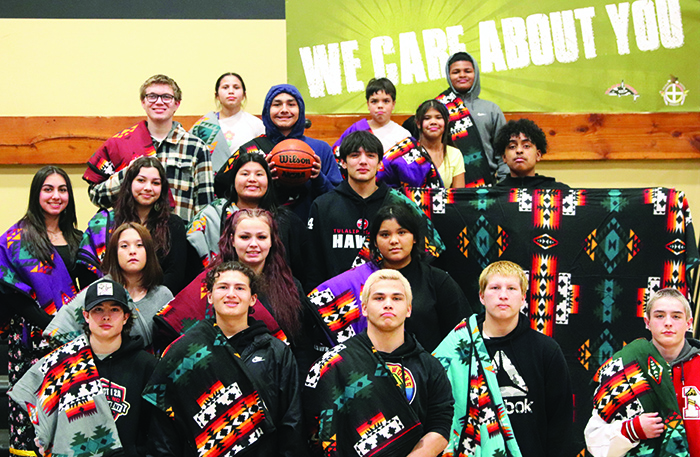
“We had a bunch of local athletes make it to the State level in their sport and thought we would come together to make that good medicine by hosting an honoring and coastal jam,” explained outreach advocate Odessa Flores. “It’s important we, as a community, take the time to hold space for these athletes and their accomplishments.”
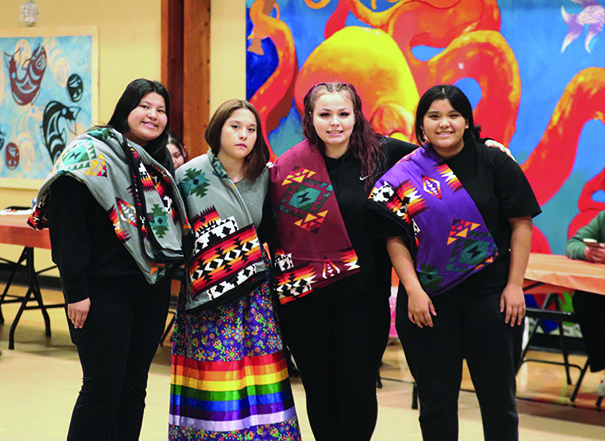
Churning out accomplished athletes is something the Reservation has no difficulty doing. It seems like every family has that legendary uncle or auntie who embellishes only slightly when recounting their on-court or on-field domination. You know the ones. They aren’t bashful and will take as much credit as they can for teaching the current crop of players everything they know.
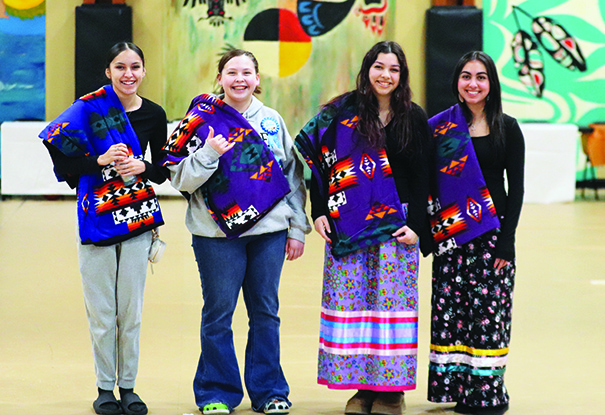
How much impact those old heads have actually had on the amazing athletes of 2025 is somewhere between incalculable and immeasurable. Past generations crawled and walked so the current generation could run. No longer forced to play just on the Reservation, proud Tulalip culture bearers now are fixtures on school teams all around Snohomish County.
Whether attending home school, public school or private school, our Tulalip athletes are excelling in the classroom and keeping themselves eligible to play sports in the fall, winter and spring seasons. More opportunity equals increased exposure and more playing time for youth who dream of playing on the college level.
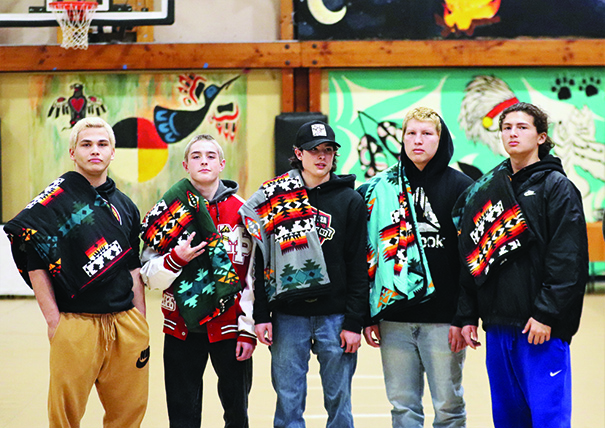
During the Youth Enrichment event, each attending athlete was wrapped in a blanket before taking to center court. Then the mic came out. One by one, the athletes stated their name, age, and sports played. As they bashfully introduced themselves in front of the large audience, the sentiment was not lost that among them could be the next RaeQuan Battle (men’s college hooper turned pro), Mikail Montez (women’s college hooper), Zues Echevarria (college footballer) or Milo Jones (college wrestler).
Often times, what separates the dreamers from the believers is simple support. Thankfully, the Youth Enrichment division is full of devoted staff members who are committed to supporting Tulalip’s youth and helping turn dreams into reality.
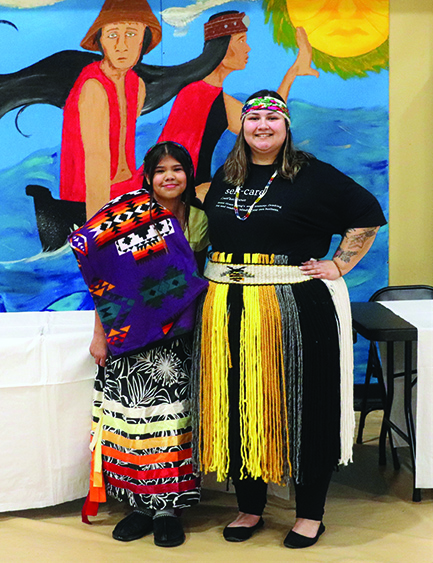
“It makes my heart so full to witness the results of all the hard work our kids put in to better themselves and better their families,” said Odessa. “We created a gratitude tree just for this event so each athlete could add their own leaf that states what they are grateful for. It really represents the deep-rooted impact each of us has on the larger community.”
March 29, 2025 syəcəb
Please use the following link to download the March 29, 2025 issue of the syəcəb
Introducing Alexis DeLaCruz, TOCLA’s Education Attorney
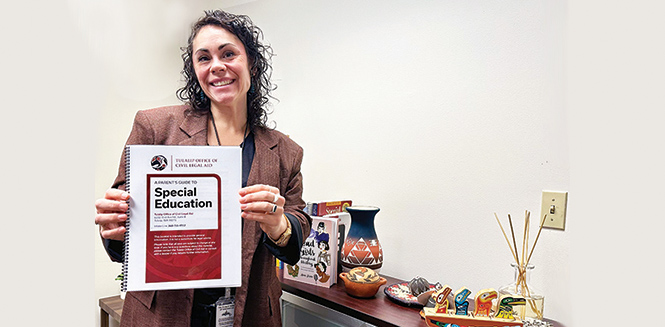
By Kalvin Valdillez, Tulalip News
Last November, the Tribe’s legal department added a new facet to their civil legal aid program. This service aims at helping Tribal children with disabilities and special needs, ensuring that they have an opportunity to thrive and succeed within the state’s education system. During their search in finding someone to represent Tulalip students, they were introduced to Alexis DeLaCruz, whose passion in education and disability rights has made a big impact in Native America, specifically for Southwest tribal nations.
That passion is fueled by her personal background, having a father with a disability and mother who dedicated her life to public school education. Among her many accolades and list of important work that she’s conducted thus far, Alexis was instrumental in the Steven C Vs. the Bureau of Indian Education, which resulted in a big win for Native students nationwide.
Alexis is looking to bring that knowledge and experience to her new position as TOCLA’s Education Attorney to help parents/guardians understand the rights that their children are legally entitled to. She plans on doing so by providing education and resources to the community at large. And when necessary, she is ready to step into the legal battlefield if an institution or school district is violating those rights.
Tulalip News recently sat down for a one-on-one with Alexis on the morning of March 20, just hours before President Trump signed an executive order to dismantle the Department of Education. Which is why it is extremely important for Tribal families to understand what this means for their students and how it will affect students with disabilities going forward.
Below, you’ll find an in-depth Q&A with Alexis. Please take a moment to read about Alexis’ new role and how she intends to uphold the Tribe’s educational values and protect the rights of its future generations.
Why don’t we start with a little bit about your background?
I am biracial. I am half Mexican American and half Anglo. I grew up in a trailer park in Denver, Colorado. I was the first in my family to go to school, to receive any type of education; the first in my family to go to law school. My first career was actually in journalism. I worked at a small daily in northwest Colorado called the Steamboat Pilot in Steamboat Springs, Colorado. I was their cops and courts reporter.
What led you to your current work?
There was an incident in my personal life. My dad was involved in a single vehicle rollover accident, and that left him a quadriplegic. It really changed the way that I viewed the world, that my family viewed the world. And just seeing the discrimination and hardship that people with disabilities face was very eye-opening to me. And at that point in my life, I was complaining a lot to my sister about the injustices that people with disabilities face every day. And she said, you either need to do something about it or stop complaining to me. And I said, ‘Okay, I’ll go to law school’. And so, I left the newspaper and started applying to law schools. I was looking for programs that had a strong commitment to social justice and public service, and that’s what led me to Seattle University School of Law. I was very myopic in my approach and what I wanted to do – a Disability Justice lawyer. I wanted to focus on disability rights work, and I was very fortunate to get connected to Disability Rights Washington, which is a statewide nonprofit that protects the rights of all Washingtonians with disabilities, including folks who live in Indian Country.
I interned for them for two years. And then my path led me to the Southwest. When I was in law school, I had not taken federal Indian law or was not necessarily connected that way. So, I’m very unique in what I do, because I’m at the intersection of disability rights work and representing Indigenous folks. And it has been the greatest gift of my life – to be invited into these spaces and to try to help kids the best I can, and their families.
Can you touch on some of your work in the Southwest?
I was in the four corners of the Southwest, working for a program called the Native American Disability Law Center, and was serving predominantly the Navajo Nation and Hopi communities, as well as the Pueblos in New Mexico. We also represented and served the reservations in southwest Colorado, parts of Utah and Arizona. I feel very strongly about my services, and so wanted to make sure it was the right change, and being able to join this strong team of incredible attorneys and advocates was the right thing. Before I started here in Tulalip, I brought a federal lawsuit against the Bureau of Indian Education called Steven C vs BIE (Bureau of Indian Education).
Do you mind expanding on the that lawsuit?
It was the first time anyone had ever held the Feds responsible for Indian education. It is one of the most important, if not the most important, education case that has ever been brought in Indian Country. And I was one of the co-architects of that lawsuit. That case was brought on behalf of individual members of the Havasupai community. They’re the tribe that lives at the bottom of the Grand Canyon. And those students only had one option to go to school. It was a BIE operated school, and it is K-6. And so, it was really important for that community to address the long-standing concerns that they had about the types of education that their students were getting.
At the time we got involved, in early 2014, students were only receiving math and English. And even only learning those two subjects, 0% of the students were proficient in either. So, our team of attorneys started looking into those issues and realized that it was more than just an individual concern, that it was really a system-wide issue that was impacting all of the students. We brought together a dream team of attorneys from a number of organizations and filed a lawsuit in January 2017 in Arizona Federal Court. That case went all the way to the 9th Circuit Court of Appeals and ended in two landmark, historic settlement agreements after the judge found that we had proven much of what we were alleging was wrong at that school. It was an important outcome for Indigenous kids in this country, particularly those who attend BIE schools.
That’s amazing. Can you speak to how that affects Tulalip students?
Here at Tulalip, there’s not an operating BIE school. There was one. Historically, there was a boarding school here. And I think many of the experiences that I’ve heard those students and families talk about sound a lot like the types of stories that this community has about how the boarding school has impacted them and how the boarding school era had impacted them. So, it’s all related. The practices that the states or the federal government can have on Indigenous students at school, it’s really a big deal. And as an education lawyer, it’s a particularly concerning time because of what’s happening at the federal level. We expect that President Trump will be signing an executive order today dismantling the Department of Ed, and I think it’s going to throw the state systems into even more chaos. And for this community, it’s been really important for me to start figuring out what Washington State’s plan is to protect not only all students, but students with disabilities, tribal students, students who have been impacted by historical trauma, students who are in foster care, students who might be involved in the juvenile justice system. Those are all core components of my work and things that I’m hoping to contribute to ensuring that Tulalip’s kids are getting not only a legally sufficient education, but one that feels holistic, afe and healthy.
Can you talk about TOCLA and your role in the department?
TOCLA is the Tulalip Office of Civil Legal Aid. We are a legal aid law firm that provides free civil legal services to the Tulalip community. I am the first-ever education attorney in this role. It’s really exciting because my understanding is this role was created in response to the community organizing and coming together and saying, ‘We need somebody who can help address the educational concerns of the community.’ It’s really, in my experience, rare and unique for a tribal legal aid program to have a position specifically earmarked to represent the educational needs of its young people. It’s so thrilling to me to be here, and I’m so honored and humbled and privileged to be in this community and working with these students and families because education is everything. If students don’t receive good quality, legally sufficient education, it impacts their outcomes later on. All of the data and the research tells us that if young people are not reading well by the third grade, it is very difficult to make that that time up. And then you add concerns about disability status. If students with disabilities are not having a free, appropriate public education provided to them, they fall behind.
When I think about my work, and approaching it with humility, I always say children are a community’s most precious resource. And I know Tulalip is incredibly committed to its children. When I was learning more about the community and just immersing myself in the traditions and the customs of the community, it was very clear to me that education is a value. It’s a priority.
Now that you’re here, what does it feels like? What are your first impressions about the community?
I have been welcomed with open arms. It has been a really beautiful experience to be invited into this community, and I think anytime a non-native person is invited in, it’s not something to take lightly. I always approach not just my individual clients, but everybody with respect. I am learning a lot, and I appreciate deeply the community trusting me with their stories and their experiences. Because it is not easy to talk about when things have not gone well at school, or when I am hearing elders talk about the impact of their time at the boarding school. We know that those experiences get passed down generationally. You might have a grandma or a grandpa who were forcibly removed from their community and sent to a boarding school and forced to assimilate into dominant culture. And then that passes to the next generation, and then that passes to the next generation.
I think approaching the work with a trauma-informed lens, and knowing that, particularly for Indigenous students, who have been very impacted by destructive, harmful federal policies and practices, and seeing that again here in 2025 is concerning. It’s also something that drives my work, like when I think about what is yet to come, there’s so much we don’t know, but I do know that when people stand shoulder to shoulder together and say, ‘We are not going to accept this, we’re going to fight for our children, we’re not going to be afraid, we’re not going to take it,’ that’s when true social change happens. And particularly in the education context. When you see successful models of education reform, it’s when students and families stand up and say, what’s happened here is not right. And again, very humbly, I am excited to continue to stand shoulder to shoulder and build on the already good work that the community has been doing to move the needle forward.
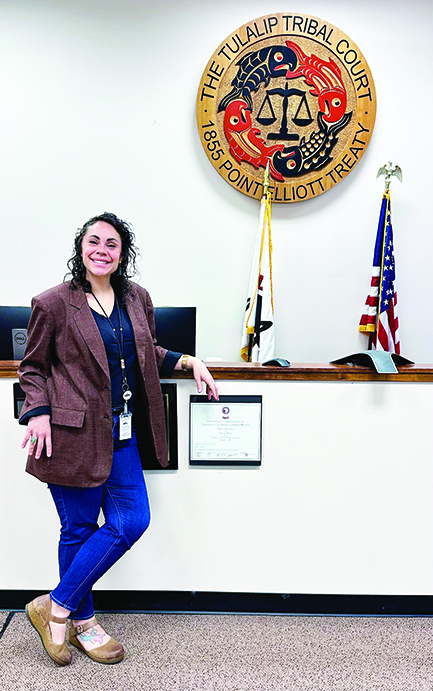
You just touched on it, but can you talk a little more about why it’s important for parents to know their rights and to know they have this support?
As I’ve been learning more about the concerns, I’ve heard stories about longstanding mistrust within Marysville School District and families – not knowing where to go or whom to turn to. A part of holding a school system accountable is knowing what your rights are. Because when people have that education, knowledge is power. When individuals can say, this is actually my right, and I’m going to stand up and do it, that is when you see students getting what they need, what they are legally entitled to. It’s when you see people taking concerns more seriously. One of the reasons I love being an education civil rights lawyer is forcing systems to do things they maybe don’t want to do or wouldn’t do otherwise, even though these rights have always existed.
For Tulalip students and families – without having access to those rights or really knowing where to go. Where do you turn? Do you go to the school’s website? Do you go to the State’s website? Who talks about this? I know, before I came on, there were a number of attorneys here doing community education presentations. And so, it’s like we’re sort of building momentum of what’s happening. When we see systems change and social movements, it’s because people have said, I know my rights and I’m going to stand up and enforce them. And this community particularly has a strong history of doing that, particularly around natural resources, like the Bolt Decision and so many other cases where this community has enforced its treaty rights. Education is also something that is included in the Point Elliot treaty. So that’s another area where folks can start harnessing some power around treaty rights.
With the looming executive order and the mistrust between Tribes and school systems, can you speak about some of those rights in regard to special needs students and examples of areas you can help with?
These laws have been on the books for 30, 40, 50 years, and so it really is about letting people know there’s a better way. It doesn’t have to be this one way. Something I tell families all the time, you might not know what your right is or what the law says, but you know when something’s wrong in your gut. Every parent, every guardian, every grandma, every auntie, every uncle that I have ever talked to, when they’ve said something felt wrong, they’ve always been correct. I always tell people, just trust your gut. If it doesn’t feel right, it’s probably not. And come and talk with me and my team. Start educating yourself about what is supposed to happen so you can educate yourself first, as your child’s first advocate and sometimes only advocate, so that you can make sure that your student or your child is getting the absolute best education that he or she can get.
With all of these rights we’ve been talking about, there are ways that you can make a complaint when things don’t go right. I’m going to take a very specific example. The Individuals with Disabilities Education Act, or the IDEA, is the primary federal law that protects students with disabilities. That law contains a set of what are called procedural safeguards that tells families what they can do to address concerns. And there are options, from what I call informal advocacy all the way to something that can look like filing a lawsuit or something that’s more formal. I can help with all of that. I have been able to help families at IEP meetings, those are Individual Education Program meetings, and that’s the place where you can come together and talk about a student’s concerns with the school. The IEP meetings are meant to be collaborative, where the student and families voice is heard, and folks talk about what a student needs – What are the parents’ concerns? What needs to happen? And maybe it’s not working for this particular student. It can be just going to meetings and supporting families that way. And then it can be looking into concerns and investigating what has happened for a student and then advising families of what those legal options are.
There’s a state complaint system. They’re called Community complaints that families can file with the state OSPI, the Office of Superintendent of Public Instruction. There’s a state complaint mechanism that you can say, I have concerns that the school has done something wrong to my student with a disability, and file that. And then you can go all the way to what’s called a due process complaint, and that’s the most formal complaint you can file under the IDEA. We do advise that folks either consult with or talk with an attorney if you’re considering that level of advocacy, because it can result in a hearing that looks like a trial, where the school will have an attorney. There will be folks testifying, and witness documents will be exchanged, and so I can do all of those.
Why is this work important to you?
The work is important to me, personally and professionally. I’m the child of a public-school teacher. My mom was an AP calculus teacher. She strongly believes in public education and ensuring that all students have equal access to good education. I am the product of a public school system. I did not go to private school. I didn’t have money growing up, and my education was my key out of poverty. Having an education literally changed my life, and I recognize the privilege that I have. And to quote Spider-Man, with great power comes great responsibility. So, it’s personally important to me to protect the rights of all kids to get a good, strong public education.
Professionally, it’s important to me to do this work in Indian Country, because not many people do it. It is important because the outcomes for Indigenous students are among some of the worst in the country. When you look at the many factors that affect education, it’s poverty, it’s where you live, it’s who your family was. Are you Brown? Are you a boy? Do you have a disability? When you’re looking at children who are most impacted, it’s typically young, brown and black men with a disability who have very poor education. Native kids, just across the scope have poorer outcomes than their nonnative, non-disabled peers. For me, it is important to continue to address the systemic issues that impact these outcomes. To continue to ensure that all kids, including Native kids, have access to education. I love what I do, and I get to work and talk to kids all day long, and when the time comes and they need someone to stand up, I will do that too. I believe that with tenacity and hope, and a heavy dose of optimism, that we will continue to move the needle forward for our community, for Tulalip.
I saw that you are gearing up for your first community gathering tonight?
Yeah! We are planning, with the Tribe’s Education Division and Positive Youth Development, to host an event every month through the rest of the year. Folks should definitely pay attention to emails, or wherever they get information, about these events. They’re going to be held once a month at 5:00 p.m. at the Admin building. We’ll be talking about a variety of things. Tonight, we’re talking about school discipline. We’ll also be talking about special education advocacy, what’s changing at the federal level, and how it might impact students, helping parents become good advocates for their children.
And I want to mention, that it does not take a lawyer to advocate for a student. It takes a parent or a guardian or a caregiver who knows a little bit about what their rights are, to stand up and say this isn’t right. Part of my role is to build capacity in the community for folks to say, I can do this. And that’s what my hope and my dream is, that individuals are able to take what they’re learning through either the materials, or meeting or working directly with me, to say I can do this. It’s just about knowing that you can ask for what your student needs and what to do if something goes wrong.
There’s going to be a big back-to-school event probably in August, and I invite people to come out and ask me questions. I’m always open to talking to anybody who wants information about education, civil rights, my door is open.
What is one thing you want parents or families to know through reading this article?
Don’t give up. There are people who are here to help. And if you have concerns about education, just come and talk with us, and let’s see what we can do together. And I really want to say, from the bottom of my heart, thank you to the community for trusting me with their stories and their hopes for their young people. I truly believe education reform starts at the community level. The Tribe, as well as individual members of the Tribe, they have the answers. They know what their community needs, what children need. And I see the law as one tool in moving that forward and effectuating that. I’m really excited about what is to come.
For more information, please contact Alexis at (360) 716-4166.
Elders Panel restored and ready to make an impact
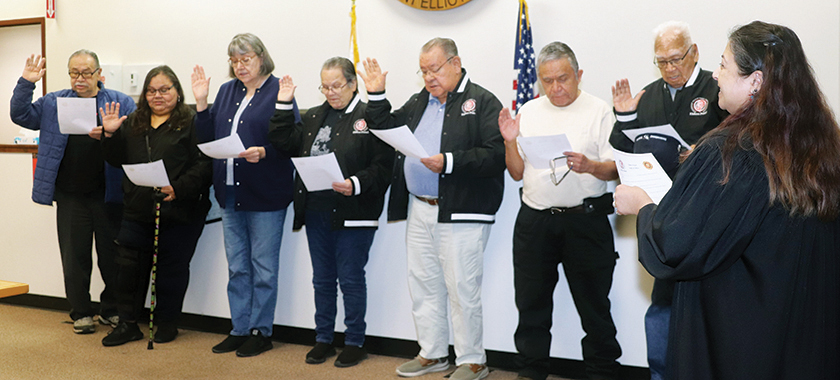
By Micheal Rios, Tulalip News
On the morning of Monday, March 24, an astounding 601 years of lived experience and accumulated wisdom convened in courtroom #3 of Tulalip Tribal Court. The 601 years representing the combined ages of Hank Williams, 94, Bernard Topash, 87, Marie Zackuse, 76, Ray Fryberg, 74, Andy James, 69, Audrey Charles, 69, Judy Joseph, 69, and Denise Hatch-Anderson, 63, who were sworn-in as members of our newest Elders Panel.
The Elders Panel program originally launched in 2006 after development by a joint effort from Tribal Court judge Gary Bass, prosecutor Tom Russell, and respected elder Donald “Penoke” Hatch. The three collaborated to create the Elders Panel to address the effects of criminal justice involvement among the youth. They thought elders could help court-involved youth by teaching them about their Tribe, present-day cultural practices, and their individual family history.
Since its ’06 inception, the Panel served hundreds of participants and yielded a near 90% success rate. However, its momentum came to an abrupt halt thanks to a global pandemic. Out of an abundance of caution to protect our community’s wisdom keepers, who were most vulnerable to Covid, the program was paused.
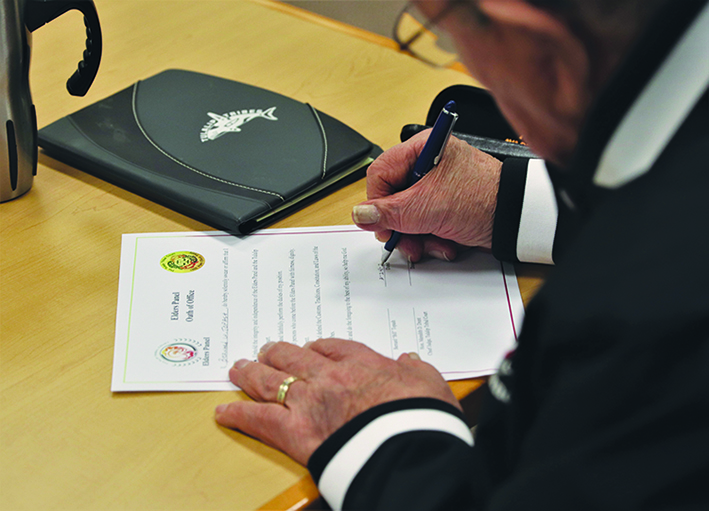
Now, after taken their oaths of office in the presence of Tribal Court Chief Judge Meredith Drent, the eight-person Elders Panel is restored and ready to change lives once again.
Among the new Elders Panel members is Denise Hatch-Anderson. She’s the daughter of Penoke who not only co-created the Panel, but was himself a sitting member of the Panel for over a decade. She understands its rather large shoes to fill, replacing her dad, but she’s excited at the prospects of engaging with youth, earning their trust, and helping them find a good way.
“I was honored my dad asked me to step into his seat because I’ve worked with the youth my whole life, retired as an educator, and know many of the families out here,” shared young elder Denise, the first 2nd generation Elders Panel member. “Many in our community have seen me in action over the last 10 years or so helping families and helping kids better themselves by getting into necessary programs. Much of the root cause is unrecognized and unhealed trauma.
“A lot of times, our youth don’t trust people, and in order to talk about their trauma, really talk about it, they need someone they trust in order to open up and start the healing process,” she continued. “With me, I’m not only a familiar face, but there’s a good chance I’ve worked with their family or even themselves individually in the past. That gives me a foundation of familiarity and trust that can really help to create open and honest conversation not just about their past, but also their future. I’m invested in their future, too, because their future is our future.”
Elders Panel is scheduled to convene the 1st and 3rd Monday of every month. They will meet with non-violent, first-time offenders, typically in the age range of 18-25, who have been charged with minor criminal offenses. Examples include possession of alcohol, possession of marijuana, and criminal mischief. Instead of prosecuting such offenders in Tribal Court, they are given an alternative route to have their offenses dismissed by participating in Elders Panel.
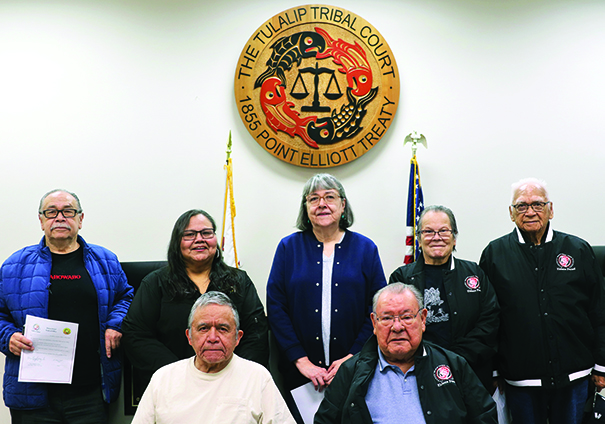
Tribal Court is actively identifying new ways to incorporate Elders Panel into additional services beyond first-time offenders. “We recognize the value and wisdom the elders bring to our justice system. [Accordingly,] the Court is seeking to build increased partnerships between the Elders Panel and other court programs, such as the Wellness Courts and Probation,” elaborated Interim Court Director Jehrad Kimble.
Elders Panel requires its participants to actively engage in their community and culture. This way, under the guidance of their esteemed elders, the individual learns the impact their actions has not just on their life, but the lives of their family and ensuing ripples created within the community as well.
Requirements may include regular appearances before the Panel, writing letters of apology, community service, mental health evaluations, and no new violations. Cultural participation can include conducting family research to create a detailed family tree and traditional activities, such as Canoe Journey, a Lushootseed class, or learning to harvest cedar.
When the defendant has completed all tasks asked of them by their Elders Panel, their case is then referred back to Tribal Court for dismissal.
“It’s a privilege for our family to be asked to work with the youth. I use the word youth because to me that’s what anyone under the age of 30 is,” said Elders Panel chairman Bernard Topash. His brother Bill served on a past Panel. “In many ways, what we are trying to do is act as grandparents.
“As an elder, I’ll tell you it’s gratifying work to help a young person find their way,” he continued. “Those who appeared before us in the past found employment, got their driver’s license and car insurance, and, without exception, learned more about their family and made a stronger connection to their Tribe.”
Enrollment in the Elders Panel program is voluntary. Those who are referred and opt-in have the opportunity to change their life trajectory. Defendants receive deferred prosecutions on their criminal charges for the length of their enrollment in the program, up to one year. Upon successful completion of the program, their charges are dismissed.
For first-time offenders, participation in a culturally-inclusive diversion program guided by elders isn’t just a chance at a fresh start. It’s a chance to reclaim a connection to their culture and find purpose within a shared community.